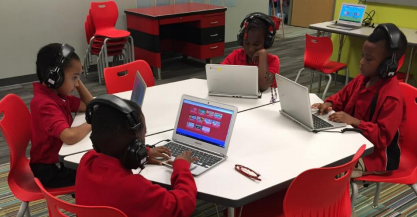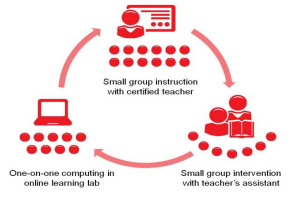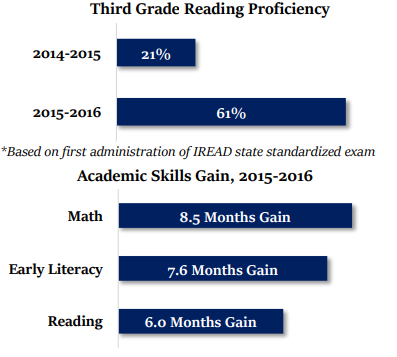PLA@103
an A-Rated School Offering Grades K-6
- PLA@103
- Now Enrolling K-6 Families in Indianapolis
Promising Practice: Blended Learning at PLA@103

Who we are:
Phalen Leadership Academy at School #103 (PLA@103) is an “Innovation Network School.” This means that PLA, a nonprofit network of public schools, has partnered with Indianapolis Public Schools (IPS) to take leadership of IPS School #103 and provide a high quality education to our children
Location: 3290 Baker Drive,
Indianapolis, IN 46235
Who we serve:
We serve 410 students in grades PK-6. Most of our students (96%) are African American, Latino or Multiracial. Currently, nearly all of our children
are eligible for Free or Reduced Price Lunches
Core pillars:
Building on research and decades of experience in raising student achievement, the PLA school model has the following pillars:
• Exceptional teachers and school leaders
• Expanded learning time, including a longer school year and school day
• Best-in-class academic curricula and enrichment courses
• Use of technology to personalize instruction
• Rigorous, frequent assessments
• Partnerships with parents
Blended learning:
PLA uses a “blended” approach to provide instruction in core academic subjects, in which students rotate through several types of learning environments. At PLA@103, one common format for instruction includes:
1) 30 minutes of whole-group instruction
2) 90 minutes of individualized learning:
• 30 minutes of one-to-one access to adaptive software
• 30 minutes of small group instruction led by a teacher
• 30 minutes of mastery-based intervention with a Teacher’s Assistant, or independent work
Because our model breaks down traditional, whole-class
instruction into smaller rotating groups of students, it ensures
that each student receives a higher degree of personalized
attention. In addition, it enables our educators to better
customize their instruction to target specific skills that
students need to master. Finally, it allows for more frequent
assessments and touch points throughout the day to create
personalized learning pathways for each child.

Key Facts
Typical class size: 25 students
Technology: 12 Chromebook laptops are available per classroom. Classrooms also have tablets,
such as iPads, which can be used for small-group or independent learning
Adaptive learning curricula: Compass Learning
Logistics: Both whole-group and individualized learning sessions are provided in each classroom,
rather than in a separate location or computer lab
Impact
Our children demonstrate strong academic need. Most of our children began the year performing significantly below their grade level; in sixth grade, our scholars were an average of two years behind. While we focused intensively on promoting a positive school culture in our first year leading School #103, we were still able to help our scholars achieve significant academic growth through our personalized learning model. Our third grade scholars increased their reading proficiency by 40% over last year!* This was the largest growth of any school in the district and state. According to their performance on the nationally-normed STAR Reading and Math exams, all of our scholars also made significant gains in literacy and math this past year.
Lessons Learned
1. Support students in transitioning to blended learning: Transitioning a school to a blended learning approach can be a challenge for all students, but particularly for elementary students, as they may not be proficient in using technology. This year, we focused on coaching students to improve their proficiency with computers and are planning to offer a technology course to comprehensively address this key skill. Now that we have made this transition, however, our children are progressing towards computer literacy at a uniquely young age.
2. Include a focus on behavior and school culture: In an instructional program that incorporates self-directed activities, students need to be able to consistently demonstrate positive behavior and take ownership of their learning to succeed at high levels. We found that it is important to intensively focus, early on, on developing a school culture and classroom management strategies that prepare students to succeed in a more rigorous and personalized learning environment.
3. Customizing professional development for each educator: Using technology to personalize instruction can also be a new strategy for some teachers, and as a result they may be hesitant to implement blended learning to its fullest effect. We found that it was important to provide training that meets teachers where they are in terms of their skill and comfort with technology, as well as to provide multiple ‘tracks’ of ongoing professional development throughout the year.

